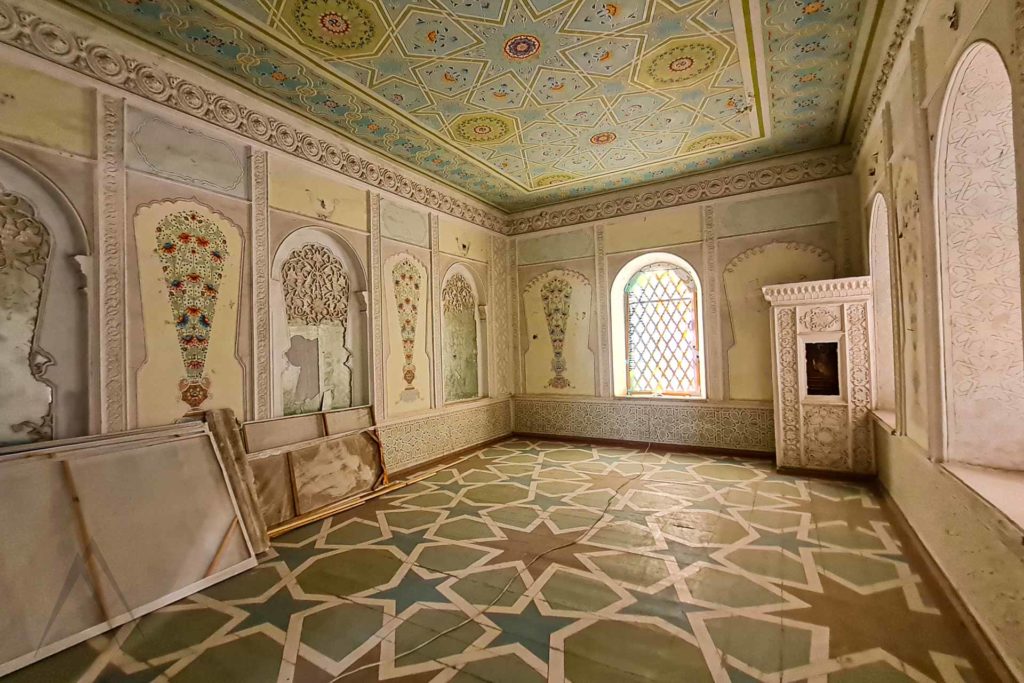Emir's palace in Kagan
Bukhara Kagan Palace
19th century Emir palace of Bukhara in Kagan is a charming building with unusual architecture for Uzbekistan and an impressive history. It is located right next to the Bukhara train station,16 km away from the Bukhara city, in the municipality of Kagan. Most tourists often pass by the palace, not noticing it from the road that passes just next to it but it is a good place to wait for the departure of your train.
This palace greatly resembles the Stori-i Mokhi Khosa summer palace meaning that it has many European palace features. The wealthy decorations of the palace displays the unimaginable wealth of the Bukharan Emirs at the turn of the 20th century. At the same time, the design and its location show the declining power of the Bukharan Emirate and the spreading of Russian colonialism that finally destroyed the Emir’s power.


To quickly establish a connection between the new territories and the central cities, the Russian Empire began to actively build railways in Central Asia. Kagan was originally known as a small village of New Bukhara or the “new town”. The settlement started to develop further in the summer of 1888 when the Russians started to settle railroad workers there.
Therefore, it could be said that Kagan palace was also established as a part of the ambitious Trans-Caspian railway development that Russian wanted to agree with Emir Abdul Ahad of Bukhara to have the permission to cross his territory. For a huge sum of silver, the Emir agreed, on the condition that the railway line did not come closer than 16 km of the city of Bukhara. Even today, there are a large numbers of ethnic Russian people who live in Kagan
History of the the Kagan palace
The Emir of Bukhara had visited St Petersburg for the coronations of Alexander III and Nicholas II. In 1895, it happened that Tsar Nicholas II was going to visit Bukhara and the Emir Abdul Ahad wished to accommodate him and his train in luxury. Therefore the the construction of a unique palace began in the summer of 1895. The best best craftsmen from all over the area, and the famous Russian architect A.L. Benois were involved in the project.
Benoit had already established a reputation in Turkestan at that point by designing a Lutheran church and a palace for the exiled Grand Duke Nicholas Romanov in Tashkent which is now the venue for receptions held by the Uzbek Ministry of Foreign Affairs. He engaged this famous Russian architect, Alexey Leontievich Benoit, to build a palace at Kagan.


The Kagan palace was finished, but Tsar Nicholas never arrived due to the political events that overtook Nicholas II. For a while, the residence was a hotel for visiting dignitaries who were not permitted to enter the holy city of Bukhara. Later, the palace was used by the tsarist Russian Political Commissar until the Soviets handed it over to the railway proletariat as a social club in 1920. After the Soviet conquest of the Bukharan emirate, it became the social club for the railway commonality.
Kagan palace today
Nowadays the palace is a bit rundown and neglected, especially inside but the Russian 19th century architecture is still mostly intact and beautiful. The rooms are not well-taken care and appear not to be very popular among the tourists. But the building is nevertheless very impressive, like an island of Russian architecture within the traditional Islamic architecture of ancient Bukhara. The palace might appear closed, but even if the doors are closed, there are always local women nearby that are willing to let you in to have a look at the interior. There is only one room with proper furniture, where there are also many old newspapers and photographs telling about the history of the Kagan palace.


Other sights near Kagan Emir's palace
Page updated 26.6.2022